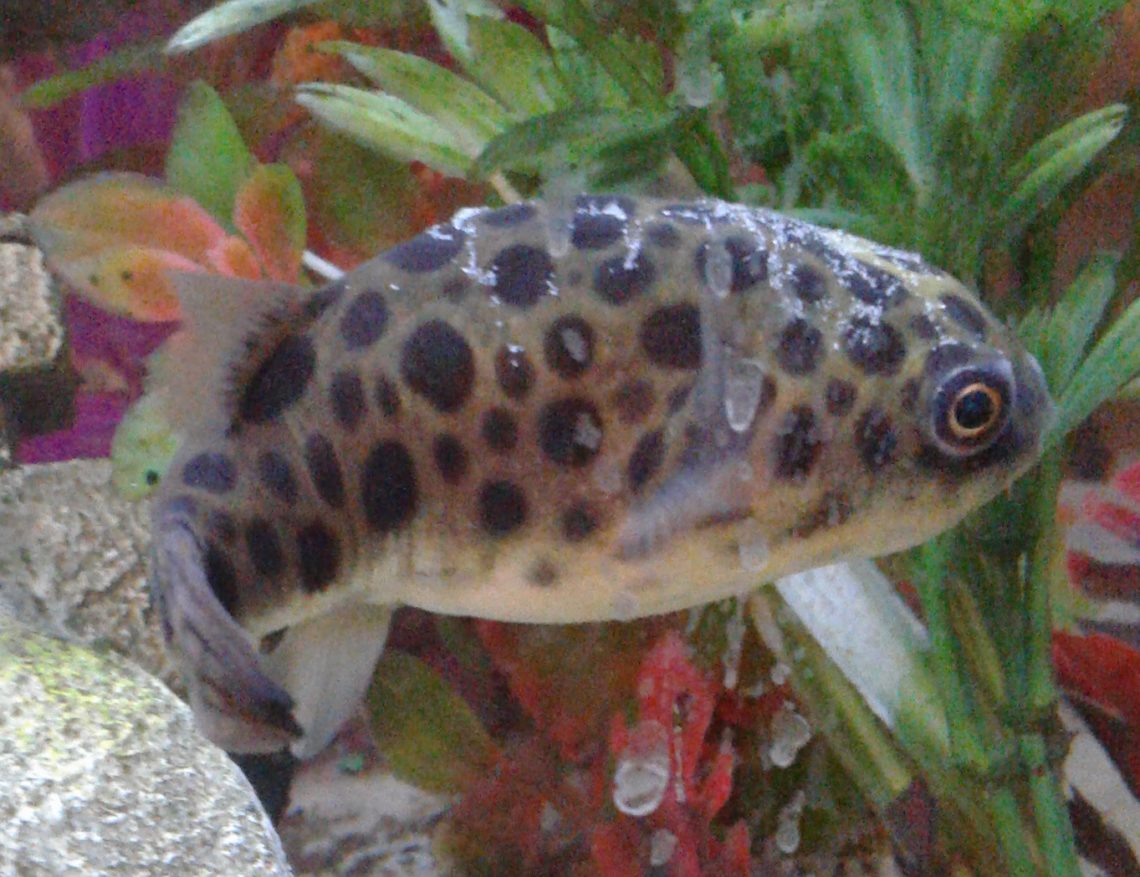
Meet My Puffer Fish
I haven’t conducted any zoo tours lately, so it’s time to introduce my readers to the fascinating and unique puffer fish. I’m always drawn to unique pets, and puffers are definitely no exception! I keep two different species of puffer fish, Pudgy the green spotted puffer fish, and my little nano tank with four pea (dwarf) puffers. I’ll give more details about my puffer fish collection later, but first I’d like to talk about what’s so special about the puffer fish.
Puffers are among the most unique fish in the world. They’re mainly found in tropical waters of Asia and Africa. They range in size from the tiny dwarf or pea puffer, which is less than an inch long, to the massive African mbu puffer which can grow up to two feet long. They can be found in fresh, brackish or marine environments, in tropical regions all over the world.
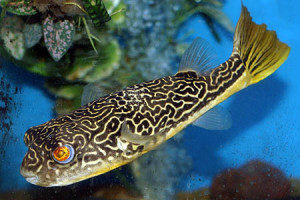
What’s really unique about the puffer is its peculiar physiology. Unlike other fish, they swim like underwater hummingbirds, and are able to hover in place, swim backwards or move in any direction they choose. Their dorsal and anal fins are set far back on their body. They use these fins and their pectoral (side) fins for propulsion and steering. They mostly use their tail for steering, but if they need to move fast they can use their tail, just as a normal fish does. They also use their tail and body as a brake, by curling their body and tail into a “c” shape. Often they will hover in one place with their bodies curled this way.
A puffer’s eyes are also different from those of other fish. Puffers have eyelids, so they can close their eyes. Their eyes protrude and are set high up and forward on the head. They can move each eye independently and in all directions. This allows them to find food and watch for predators at the same time. A puffer’s eyes have a shiny, reddish iris which may help them to see better in the dark. One thing puffers can see very well, better than most other fish, is the outside of their tank. They will swim along and follow movement outside the tank and quickly learn to recognize their owners and even beg for food. They easily learn to eat from the owner’s hand, and some people think of them as aquatic puppies.
The skin of a puffer is also unique. It’s leathery and they don’t have scales. Instead they have spines which lay flat on the skin. On most puffers (like Pudgy) the tiny spines are invisible when laying flat, but there are some marine species which have larger spines. The spines are mainly used if the puffer inflates itself for defense. They can fill themselves with either water or air. What most people don’t know is that puffers only inflate themselves as a last resort if they are caught, because when they inflate it often ruptures internal organs and kills them. If they inflate with air, they can’t expel the air and again will die. This is why it’s a bad idea to use a fish net to catch a puffer – it could cause them to inflate and die. Instead a cup should be used.
The most striking thing about a puffer’s skin is its ability to change colour, just like a chameleon. Baby green spotted puffers in pet stores are usually a pale green colour with black spots and a white belly. As they grow older, they start changing colour at will. The green can be any shade, even dark, almost black, and the spots may disappear. When they sleep they turn almost completely black. They also develop a thick, protective mucus coating on their skin while they sleep. Pudgy gets sand caught in that coating when he sleeps, you can see it on his back in the main pic. That white tummy can turn completely black, or develop a black line from nose to tail. The black belly means they’re asleep or uncomfortable (for example if the water quality is poor). Even their tail fin can become darker or lighter. Finally, the green spotted puffer fish develops what I call a “head light” – a bright yellow patch on their foreheads, surrounding the black spots. The colour changes are quite fast and you can see them change before your eyes.
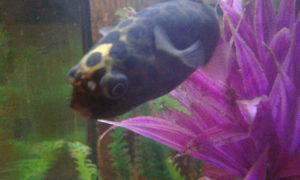
The final oddity about puffers is their teeth. A puffer’s teeth are fused together to form four hard plates. These allow them to crush and break shells and corals to get at their food. Their teeth plates grow constantly, to prevent them from wearing out. Puffers are carnivores, their favourite food is mollusks – snails, clams, mussels. They will also eat crustaceans (shrimp, crayfish) and even nip pieces from the fins of larger fish. Pudgy will sometimes eat bottom feeder shrimp pellets – but only if I feed them to him by hand! In captivity they should be fed items that wear their teeth down, because the teeth can become overgrown and the puffer won’t be able to eat. Sometimes it may be necessary to clip the puffer’s teeth if they’re overgrown.
The puffer’s carnivorous diet means most species can’t be kept with other fish species, nor can they be kept with mollusks or crustaceans (at least if you want to keep them). They also require heavy filtration and pristine water due to their messy eating habits. They’re aggressive and always on the lookout for a bite to eat. They will even attack their own kind. This is why Pudgy has his own 30 gallon palace. Thirty gallons is the minimum size tank for one green spotted puffer. Smaller species like the dwarf or Amazon puffers can sometimes be kept with other fish, as long as they are fast moving fish and the tank is heavily planted. All puffers should be fed mostly hard foods to wear their teeth down. Many people breed snails in a separate tank as feeders for their puffers.
Puffers are fascinating, highly intelligent and curious, unique, and fun to watch. What’s not to like? As I mentioned before, they have very specific needs and I don’t recommend most species for beginners. Sadly, only two species in the pet trade (the Amazon and pea puffers) have ever been known to breed in captivity, this means those cute pudgy little helicopters in the pet stores are wild caught. The dwarf puffer’s numbers have suffered thanks to overfishing for the pet trade, this may happen to other species soon. They can carry parasites, though there aren’t many reports of this. It also means that they are not acclimatized to captive conditions, and thousands die before they make it to the pet stores. Once they get there, ignorance about their proper care means more puffers die. I strongly recommend that anyone who wants to keep a puffer should thoroughly research the species they are interested in, and bear in mind that most pet store staff know nothing about puffers, so their advice is suspect.
My Puffers
Pudgy is my green spotted puffer. He lives in his own 30 gallon tank, in a marine (salt water) environment. He’s over 4 inches long now, and could grow up to 6 inches. I’ve had him for nearly 2 years. Puffer fish are long lived, and Pudgy could live for up to 10 years. He’s pretty sedentary, spending about half of his time curled up like a puppy sleeping on the sand in a cozy corner. He likes to eat in the evenings, and at this moment he’s swimming around near the surface of the water, hoping I’ll come by and hand feed him some shrimp pellets, his favourite crunchy treat. He won’t eat pellets unless I hand feed them, he’s spoiled! Like other puffer fish, Pudgy can see very well outside of his tank, so he knows when I’m coming.
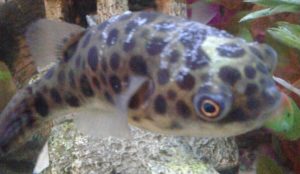
For a green spotted puffer fish like Pudgy, proper care means gradually adding more reef salt to their tank over a period of months as they grow to adulthood (6 inches long). This is because in the wild they hatch in fresh water, then as they get bigger they move downstream to the ocean. Usually pet stores sell them in fresh water because that’s where the juveniles are caught. However, if they are kept in fresh, or even brackish (slightly salty) water, they will eventually die. As the salt content of the water increases, the tank needs to be switched from freshwater to marine filtration, test kits and other equipment. I currently have a protein skimmer on Pudgy’s tank, the next step will be adding 50 lb of live rock for more natural filtration.
I also keep dwarf, or pea puffers. I would recommend these endearing little guys to anyone who wants their first puffer fish. They are tiny, about half an inch long, and they should be kept in a group of no less than three fish. They can live in a 15 gallon nano tank. Like the bigger varieties, it’s best not to keep pea puffers with other fish or most snails, however, I’ve found I can keep them with thorny nerite snails. Nerites are tidal snails and keep their bodies tucked under their shells, where little puffers can’t reach.

I keep my pea puffer tank on my coffee table where I can spend time watching it. These little fish are highly intelligent and constantly busy – mainly trying to bully each other! They claim little areas of the tank as their own, then lunge at each other without actually doing any damage. Watching them is addictive as they defend their little domains and constantly check out every little nook and cranny of the tank.
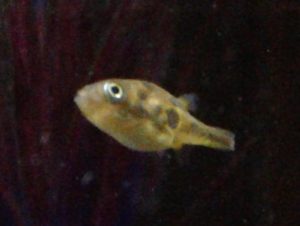
They have all the same physical attributes as their bigger cousins: they swim like tiny helicopters, roll their little eyes and turn their heads as they look around, and change colour from bold black spots on white to dull yellowish olive green. They crowd to the front of the tank if there’s something interesting outside the tank (like me coming with a little container of thawed bloodworms) and they slurp those worms down like spaghetti, even when the worm is longer than they are. Then they get fat little bellies, which makes them look like the peas in their name.
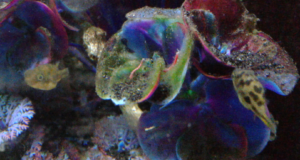
Other Starter Puffer Species
A cousin of the green spotted puffer which is less daunting to keep is the figure eight puffer. They are named for the striking pattern on their back and head. I have kept this species in the past, however back then there was less information available about puffer fish. They’re sometimes found in pet store tanks alongside the green spotted puffer, but they come from a different part of the world (Southeast Asia) and a different habitat (fresh water or low brackish). They only grow to 3 inches long. They do better in low brackish water than fresh, and they survive longer when only one is kept per tank. They eat a similar diet to the green spotted puffer, but are somewhat less aggressive towards other fish and can be kept with fast moving species like barbs or rasboras, as long as there are plenty of plants and hiding places.
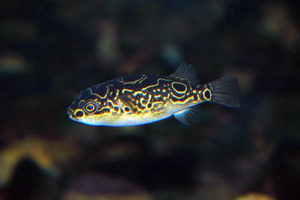
Another puffer fish suitable as a “starter” is the Amazon puffer (3 inches). Amazon puffer fish are freshwater fish so there’s no need to worry about salt in the water, however like any puffer they’re messy eaters and need pristine water. Amazon puffers are smaller than the figure eight puffer but larger than the pea puffer, and require about 15 gallons per fish. They should not be kept with other fish species, however like dwarf puffers they should be kept in groups. They prefer a current in the water, since they come from the Amazon river. Like all puffer species, Amazon puffer fish are highly intelligent and curious, and it’s a good idea to rearrange their tanks every so often to prevent boredom. When bored they will swim aimlessly up and down the tank glass.
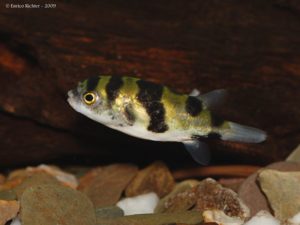
If cared for properly, most puffer species can live for more than 10 years. However, their special needs mean they’re not for everyone. If you do bring a puffer fish into your home, you will be rewarded with a unique and interactive pet.

